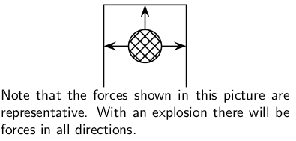| << Chapter < Page | Chapter >> Page > |
The answer makes sense as we need a bigger force upwards to cancel the effect of gravity as well as make the lift go faster.
Stage 3:
The lift moves at a constant velocity.
When the lift moves at a constant velocity, it means that all the forces are balanced and that there is no resultant force. The acceleration is zero, therefore F = 0. The force acting upwards is equal to the force acting downwards, therefore F = 4900 N.
Stage 4:
The lift slows down at a rate of 2m s .
As the lift is now slowing down there is a resultant force downwards. This means that the force acting downwards is greater than the force acting upwards. To find the magnitude of the force applied by the cable (F ) we can do the following calculation: Again we have chosen upwards as positive, which means that the acceleration will be a negative number.
This makes sense as we need a smaller force upwards to ensure that the resultant force is downward. The force of gravity is now greater than the upward pull of the cable and the lift will slow down.
Stage 5:
The cable snaps.
When the cable snaps, the force that used to be acting upwards is no longer present. The only force that is present would be the force of gravity. The lift will freefall and its acceleration can be calculated as follows:
As with lifts, rockets are also examples of objects in vertical motion. The force of gravity pulls the rocket down while the thrust of the engine pushes the rocket upwards. The force that the engine exerts must overcome the force of gravity so that the rocket can accelerate upwards. The worked example below looks at the application of Newton's Second Law in launching a rocket.
A rocket is launched vertically upwards into the sky at an acceleration of 20 m s . If the mass of the rocket is 5000 kg, calculate the magnitude and direction of the thrust of the rocket's engines.
We have the following:
m = 5000 kg
a = 20 m s
F = 5000 x 9,8 = 49000 N
We are asked to find the thrust of the rocket engine F .
We will apply Newton's Second Law:
How do rockets accelerate in space?

Gas explodes inside the rocket.
This exploding gas exerts a force on each side of the rocket (as shown in the picture below of the explosion chamber inside therocket).

Due to the symmetry of the situation, all the forces exerted on the rocket are balanced by forces on the opposite side, except for the forceopposite the open side. This force on the upper surface is unbalanced.
This is therefore the resultant force acting on the rocket and it makes the rocket accelerate forwards.
A lift, mass 250 kg, is initially at rest on the ground floor of a tall building. Passengers with an unknown total mass, m, climb into the lift. The lift accelerates upwards at 1,6 m s . The cable supporting the lift exerts a constant upward force of 7700 N. Use g = 10 m s .

Let us look at the lift with its passengers as a unit. The mass of this unit will be (250 + m) kg and the force of the Earth pulling downwards (F ) will be (250 + m) x 10 m.s . If we apply Newton's Second Law to the situation we get:

Notification Switch
Would you like to follow the 'Maths test' conversation and receive update notifications?